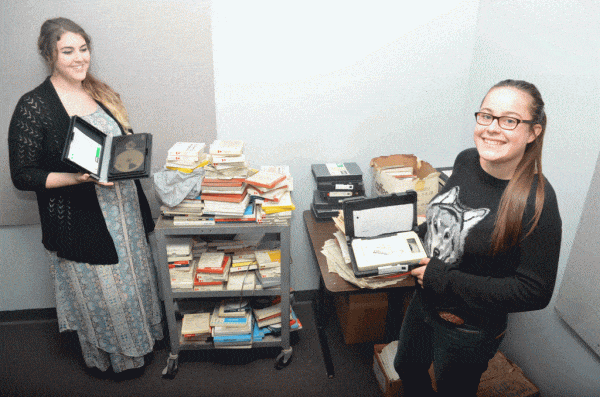By Alicia K. Gosselin

In the basement of C-building, a dusty storage closet sat untouched for almost 20 years.
But this past August, when a renovation project forced the closet doors open, hundreds of vintage scripts, audio and videocassettes revealed a glimpse into Algonquin’s broadcasting program of the past.
“I was like a kid in a candy store when we found out,” said Dan Mellon, a professor in radio broadcasting at the college. “We didn’t even know to look for them – the dust was unbelievable.”
The dates on the scripts and tapes are marked between 1988 and 1995.
At first glance, Mellon and his colleague, Dan Pihlainen, also a professor in radio broadcasting, noticed several notable names from the broadcasting industry written in pen across the cardboard audio cases. Some of the names included Sandra Plagakis from 105.3 KISS FM, Jeff Hatherall from Hot 89.9 and Mike Murphy from 580 CFRA. All were students at Algonquin at one time.
“There’s a lot of history in there,” said Pihlainen, pointing to a heap of cassettes. “We really want to see all of it digitized so everyone can access it – but good luck finding a machine that will play the videos.”
Although all of the audio cassettes can be digitized using a reel-to-reel audio tape recorder, transferring the videocassettes will be more of a challenge. The program does not have access to a three-quarter inch U-matic tape player, which is the equipment required to view the tapes.
A studio in Kanata called Home Video Studios specializes in transferring aged formats into digitized versions. According to David Gardner, the director at Home Video Studios, the cost to transfer just one U-matic videocassette would be around $60.
“We’d have to buy it as an antique,” said Pihlainen, sighing. “Or just keep reaching out to people to see if anyone owns one and maybe we’ll get lucky.”
Mellon said reaching out to the City of Ottawa and National Archives might be an option to find the proper video playback as well – digitizing the contents will be essential in preserving the history of the broadcasting program.
“The tapes are pretty significant because they speak to the legacy of the program,” he said. “Like, how many broadcasters have come through here and gone on to big jobs in the industry?”
Brian Slack, a consultant from physical resources who has been with Algonquin since 1967, found the tapes during construction for the new Student Emergency Relief Centre and contacted the chair of media studies, Robyn Heaton, right away.
Heaton also felt the discovery marked a significant impact on the program.
“Capturing moments in the history of CKDJ is very important,” she said. “Not only will they be used as research for the history of the station and the program, but could also assist teaching.”
If anyone has any information concerning a three-quarter inch U-matic videocassette player that can be used to digitize the tapes, please contact Dan Mellon at mellond@algonquincollege.com


